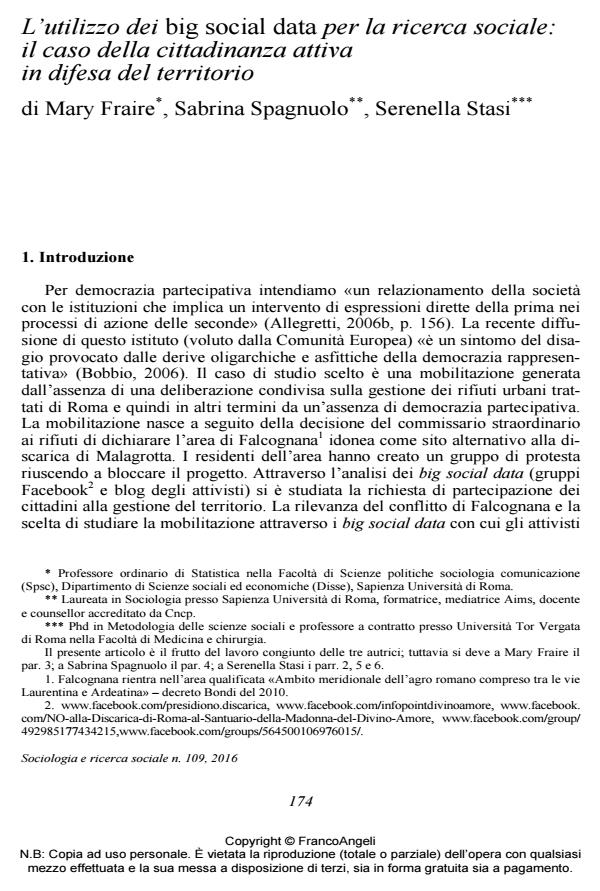The Use of Big Data Social for Social Research: the Case of Active Citizenship in Defense of the Environment
Journal title SOCIOLOGIA E RICERCA SOCIALE
Author/s Mary Fraire, Sabrina Spagnuolo, Serenella Stasi
Publishing Year 2016 Issue 2016/109 Language Italian
Pages 14 P. 174-187 File size 269 KB
DOI 10.3280/SR2016-109014
DOI is like a bar code for intellectual property: to have more infomation
click here
Below, you can see the article first page
If you want to buy this article in PDF format, you can do it, following the instructions to buy download credits

FrancoAngeli is member of Publishers International Linking Association, Inc (PILA), a not-for-profit association which run the CrossRef service enabling links to and from online scholarly content.
The article presents a case-study of urban conflict on waste management originating from the lack of a shared decision. Facebook posts and blog are analyzed as vehicles used by citizens for information and expression for democracy. The study proposes the Automatic Analysis of Textual Data (AADT) performed by IRaMuTeQ software and the related conceptual map of the 7 statistical phases which have allowed to structure the unstructured data. The AADT has then been compared with the Semiautomatic Analysis of textual Data (ASDT) performed by the software Nooj
- T. De Mauro, F. Mancini, M. Vedovelli, M. Voghera (1993), Lessico di frequenza dell’italiano parlato, Milano, Etas Libri.
- M. Fraire (1994), Metodi di analisi multidimensionale dei dati, Roma, Cisu.
- M.S. Agnoli (1994), Concetti e pratica nella ricerca sociale, Milano, FrancoAngeli.
- U. Allegretti (2006a), «Verso una nuova forma di democrazia: la democrazia partecipativa», Democrazia e diritto, 3, pp. 7-13, DOI: 10.1400/76377
- U. Allegretti (2006b), «Basi giuridiche della democrazia partecipativa in Italia: alcuni orientamenti », Democrazia e diritto, 3, pp. 151-66, DOI: 10.1400/76391
- B. Berelson (1952), Content Analysis in Communication Research, Glencoe (IL), Free Press.
- L. Bobbio (2005), «La democrazia deliberativa nella pratica», Stato e mercato, 1, pp. 67-88, DOI: 10.1425/19634.L.Bobbio(2006),«Dilemmidellademocraziapartecipativa»,Democraziaediritto,4,pp.11-26,doi:10.1400/93056
- S. Bolasco (2013), L’analisi automatica dei testi. Fare ricerca con il text mining, Roma, Carocci.
- S. Bolasco, L. Lebart, A. Salem (1995), Analisi statistica dei dati testuali, Roma, Cisu.
- N. Chomsky (1969), L’analisi formale del linguaggio, Torino, Boringhieri.
- R.J. Dalton (1988), Citizen Politics in Western Democracies: Public Opinion and Political Parties in the United States, Great Britain, West Germany, and France, Chatham (NJ), Chatham House.
- F. Della Ratta-Rinaldi (2000), «L’analisi testuale: uno strumento per la ricerca sociale», Sociologia e ricerca sociale, XXI, 61, pp. 102-27, DOI: 10.1400/69145
- M. Delle Donne (2016), Prefazione, in C. Facioni, S. Spagnuolo, S. Stasi, Movimenti sociali e conflitti territoriali. Nuovi strumenti di analisi, Ariccia, Aracne.
- M. Fraire (2000), «Analisi a tre-vie nelle risposte a domande aperte e indicatori empirici», Sociologia e ricerca sociale, XXI, 61, pp. 87-101, DOI: 10.1400/69144
- M. Fraire, A. Rizzi (2013), Analisi dei dati per il data mining, Roma, Carocci.
- M. Fraire, F. Sessa, S. Spagnuolo, S. Stasi, S. Marino (2015), «Mobilitazioni dei cittadini per il territorio: analisi testuale dei social network e delle comunicazioni istituzionali», Cahier, 5, pp. 135-53.
- B. Gbikpi (2005), «Dalla teoria della democrazia partecipativa a quella deliberativa: quali possibili continuità», Stato e mercato, 1, pp. 97-130, DOI: 10.1425/19636
- L. Giuliano, G. La Rocca (2008), L’analisi automatica e semi-automatica dei dati testuali, Milano, Led.
- G. Granieri (2005), Blog generation, Roma-Bari, Laterza.
- J. Grimmer (2015), «We are all Social Scientists now: How Big Data, Machine Learning, and Causal Inference work together», Political Science & Politics, 48, 1, pp. 80-3, DOI: 10.1017/S1049096514001784
- Istat (2014), Cittadini e nuove tecnologie statistiche report, http://www.istat.it.
- H.D. Lasswell (1942), «The Relational of Ideological Intelligence to Pubblic Policy», Ethics, 53, 1, pp. 25-34.
- A. Rizzi (1985), «Alcune analisi statistiche della lingua italiana», Statistica, XLV, pp.147-157.
- A. Shutz (1950), «Language, Language Disturbances, and the Texture of Consciousness», Social Research: An International Quarterly, XVII, pp. 365-94.
- G. Tipaldo (2014), L’analisi del contenuto e i mass media, Bologna, il Mulino.
- A. Touraine (2012), Dopo la crisi una nuova società è possibile, Roma, Armando.
- S. Weil (1949), L’enracinement prélude à une déclaration des devoirs envers l’être humaine, Paris, Gallimard; tr. it., La prima radice. Preludio a una dichiarazione dei doveri verso l’essere umano, Milano, SE, 1990.
- G.U. Yule (1939), «On Sentence-lenght as a Statistical Characteristic of Style in Prose: With Application to Two Cases of Disputed Authorship», Biometrika, 30, 3-4, pp. 363-90.
- La valutazione pluralista e democratica per un progetto di support a cargiver e pazienti in una prospettiva di genere Sabrina Spagnuolo, Serenella Stasi, in RIV Rassegna Italiana di Valutazione 71/2019 pp.31
DOI: 10.3280/RIV2018-071003 - Psychometric properties of the Italian version of the staff attitude to coercion scale: an exploratory factor analysis Paola Venturini, Giulia Bassi, Silvia Salcuni, Georgios D. Kotzalidis, Carla Ludovica Telesforo, Eleonora Salustri, Manuela Trevisi, Valentina Roselli, Lorenzo Tarsitani, Vittorio Infante, Cinzia Niolu, Gianmarco Polselli, Tommaso Boldrini, in Frontiers in Psychiatry 1172803/2023
DOI: 10.3389/fpsyt.2023.1172803 - Handbook of Research on Advanced Research Methodologies for a Digital Society Costantino Cipolla, pp.42 (ISBN:9781799884736)
Mary Fraire, Sabrina Spagnuolo, Serenella Stasi, L’utilizzo dei big social data per la ricerca sociale: il caso della cittadinanza attiva in difesa del territorio in "SOCIOLOGIA E RICERCA SOCIALE " 109/2016, pp 174-187, DOI: 10.3280/SR2016-109014